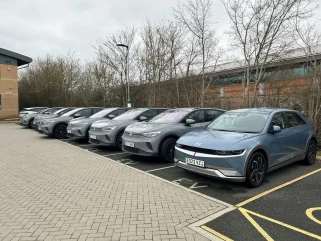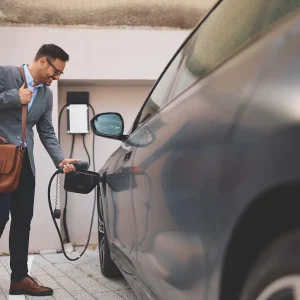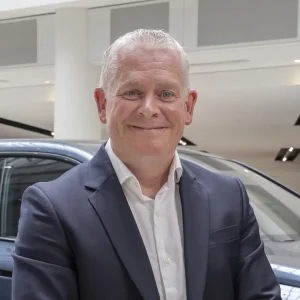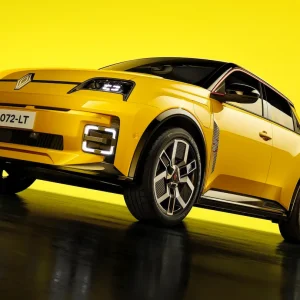
In the world of new home construction, the quality and reliability of a build are paramount.
Since its establishment in 1936, the National House Building Council (NHBC) has stood as the UK’s leading provider of warranty and insurance for new homes.
Independent of government and the construction industry, the NHBC dedicates itself to instilling confidence in the construction quality of new homes through training and quality services, rigorous assessment, and inspection of new homes registered with it for warranty and insurance. Last year alone, NHBC conducted over one million inspections, underscoring its dedication to new home quality.
Benjamin Mann, with a background in procurement at Sainsbury’s Argos, brings extensive experience to his role as sourcing and contract specialist within NHBC’s Procurement team. Since 2020, Mann has overseen fleet operations from a contract management and procurement perspective. In August last year, the full fleet provision officially transitioned to procurement, marking a significant shift in responsibilities. “Fleet management used to be under HR, but now it’s within my purview,” Mann explains. “It’s important to clarify how my role and responsibilities have evolved.”
Fleet management isn’t the only green initiative at NHBC, but Mann says it’s one of the most impactful and aligns closely with the company’s broader ESG strategy. The procurement team collaborates closely with different parts of the business to develop the necessary skills and insights. “We have excellent partners in Novuna as our leasing provider and CMC as our fleet consultant,” Mann notes. “These partnerships are crucial in helping us refine our fleet management strategies.”
Mann tells us that fleet is vital to what NHBC does, enabling it to deliver core services to its customers. Fleet operations are vital to NHBC’s mission and service delivery. The predominant roles out on the roads are its building inspectors and claims investigators.
Reflecting on his experience managing the fleet, he shares: “Our role in procurement isn’t just about acquiring resources; it’s about ensuring that these resources enable our teams to perform efficiently and effectively on the ground.”
Mann joined NHBC in 2018 but only began working on fleet in 2020. At the time the company faced significant challenges, primarily due to its entirely diesel-powered fleet and limited market solutions for transition. “This was particularly problematic because our vehicles often cover large, rural areas, making diesel a practical but environmentally taxing choice,” he notes.
The fleet’s reliance on diesel resulted in substantial BIK rates, impacting a large portion of NHBC’s workforce. “We need between 600 and 700 colleagues in the field most of the time, which is the majority of our 1,300 employees. They need the right tools – or cars – to do their jobs, and back then they were not all satisfied,” Mann explains.
Meeting the 2030 net-zero target required significant changes within just three fleet rotations. Recognising the urgency, the team began transitioning away from diesel vehicles.
The fleet was NHBC’s largest direct CO2 emitter, a critical concern for a company with a focus on sustainability. “By the end of March 2020, we were locked down for Covid, and the opportunist in me and the team saw that as a chance,” Mann says.
By April, the team had developed a proposal for the executive team to transition away from a diesel-dominated fleet. “For the first time, we included options for electric and PHEVs, while still maintaining diesel for those unable to transition immediately,” Mann continues.
They initiated a highly competitive tender process and an internal eligibility review, reinvesting all savings back into the scheme and increasing the new vehicle budget to allow for the inclusion of electrified vehicles for the first time.
An unparalleled investment
With a fleet of around 700 cars and a portion designated for senior managers the fleet’s job-need population currently consists of 628 drivers. With 63% transitioning to EVs and 30% to PHEVs, Mann estimates that these drivers have collectively saved approximately £22 million in tax per annum compared to the baseline diesel cars they would have otherwise driven.
For these drivers, this shift is significant not only environmentally – moving from 1.6/2 litre diesels to greener options – but also financially, thanks to favourable government BIK rates. Mann explains. “This combination of environmental and financial benefits has made the decision to transition easier.”
Working closely with its manufacturer partners, NHBC reexamined its cost structure to accommodate EVs and PHEVs. “Many fleets don’t consider the whole-life cost of vehicles, but when you do, it becomes clear that the running costs for an EV are much lower,” notes Mann.
Just over half of the fleet now consists of Volkswagen ID4s. The original launch of this vehicle coincided with the introduction of the new fleet policy in April 2021. With a range of approximately 330 miles, Mann describes it as the perfect workhorse for the fleet.
As of June 2024, with the final wave of deliveries, the fleet anticipates having just over 70% of its fleet converted to EVs, nearly 24% to hybrids, and the remaining 6% still using diesel.
This transition has so far led to an 84% reduction in average CO2 grams per kilometre for the fleet compared to January 2020. In real terms, Mann estimates a 48.8% reduction in total CO2 emissions. The discrepancy between the per-kilometre reduction and the total reduction is due to the way hybrid CO2 emissions are calculated and the delayed lead times for vehicle transitions.
“I recognise that our fleet isn’t the largest, but I believe transitioning so many drivers to EVs and achieving our current progress is a significant accomplishment,” says Mann.
Driver satisfaction goals
Once the cars were decided upon, the focus shifted to getting the drivers comfortable with their new electric cars. In a partnership with leasing company Novuna, Mann and his team worked on conveying the message of how to live with an EV to drivers. Novuna offers drivers tools including an EV hub which allows users to input details such as their mileage, location, and rural travel requirements to determine how an EV fits into their lifestyle.
On average, Mann explains that the drivers aren’t travelling more than 200 miles a day, making a 300-mile range EV more than suitable for their needs. This includes areas in the north, rural regions, and building sites, where there is a greater expanse of land per employee and a scarcity of public charging infrastructure if they need to charge to get home.
“Back in 2020, the main barrier to entry was range anxiety – whether these cars could really achieve a 320-mile range,” Mann shares, “While they may not reach that, the focus has shifted. Now, the primary consideration is whether drivers can have a home charge point. If the answer is yes, making an EV work becomes much more feasible.”
Although it took some time and encouragement to get some drivers into electric cars, Mann tells us how he regularly interacts with the building inspector teams, noticing that every single member is driving an EV. “They are always keen to share their experiences, highlighting significant tax savings and reduced personal mileage costs, all while driving a desirable, higher-value car. This word-of-mouth endorsement has been incredibly powerful. As much as we’ve promoted the benefits, our drivers have become the biggest advocates for the switch. We have a culture of achieving these objectives, and this initiative has been no exception.”
Additionally, the team decided to relaunch its senior perk scheme. Senior cars had not been particularly popular until the zero per cent BIK rate came into effect, but this change caused their popularity to skyrocket. “This shift allowed us to demonstrate leadership from the top,” says Mann, “with senior business leaders adopting EVs to set an example and align with our company’s sustainability goals.” The initiative has resulted in a 90% uptake of for senior managers with the majority being EVs. “This means nine out of ten senior leaders are now driving predominantly EVs,” which is an amazing achievement,” says Mann.
PHEVs: A stop-gap solution
When it comes to PHEVs, Mann explains they were an interesting choice for the fleet, viewed as a transitional step toward full electrification, but the fleet has decided it’s time to fully phase them out. “Although they were a concession, they allowed us to pave the way for a fully electric fleet in the future,” Mann notes. “We understood there was some hesitation and that not everyone was ready to fully transition to EVs, but hybrids have underperformed for us – not due to any specific manufacturer or vehicle, but because they often aren’t used as intended,” he explains.
The fuel spend analysis conducted by Mann and his colleagues indicates that, unfortunately, a small minority of hybrid users are not maximising their potential.
However, the situation has changed dramatically. Now, many of the 37% of drivers who initially didn’t switch are eagerly anticipating the end of their leases so they can move to an EV.”
The fleet is currently pausing new orders pending updated policy changes and a review of its car offerings. Starting this financial year, the fleet will only order EVs, except in exceptional cases, such as employees living in rural areas with limited infrastructure and no home charging options. “We just don’t see hybrids as a viable alternative moving forward,” Mann explains. “In transitioning to an all-EV fleet, the only remaining barrier is whether a driver can have a home charge point. If the answer is no, they will have to rely on public infrastructure. We are working on compensating those drivers and providing them with a rate that actually works for their needs.”
Giving something back
The next significant change the team implemented was simplifying fuel reimbursement. Previously, Mann says business miles were offset by private miles, but the decision was made to transition to the government’s AFR and AER schemes, which they quickly found were not suitable for EV drivers.
Mann and his team also introduced a subsidised home charge point initiative, initially offering a 50% subsidy for home charge points. To date, the company has installed 400 in the homes of its employees. This not only helped drivers reduce their tax burdens, but also supported the goal of lowering the CO2 emissions of the fleet. Additionally, they have installed the first wave of charge points at the Milton Keynes office.
Cutting costs, not corners
Mann explains that the next big challenge for his team is finding ways to limit costs from the ongoing fleet spend, without impacting the satisfaction and safety of the drivers.
The team is now working on implementing an updated fleet policy through 2030, which, pending approval, will allow for an all-colleague salary sacrifice scheme to be introduced this year. While many of the organisation’s employees already use fleet cars, Mann realises that the area of own-car travel is another source of emissions, which the new scheme aims to address and further align the company’s operations with its sustainability goals.
“I believe the salary sacrifice scheme is a game-changer,” notes Mann. “Pricing has been a significant challenge over the past few years, as manufacturers have supported models and leasing companies have struggled with the EV second-hand market. This means that pricing will continue to be a major challenge for us and we need to figure out ways to save in other areas.”
Another future focus for Mann is driver training, an area that hasn’t received much attention yet. Currently, the fleet is guided primarily by policy, which Mann admits is not the best way to address this issue.
“We currently lead through policy, which we acknowledge isn’t the most effective approach. In the future, we plan to develop more comprehensive driver training programs,” Mann states. “This transition hasn’t progressed as quickly as we would like because we are still searching for a suitable provider.”
As the fleet continues to move to EVs, Mann says he wants to focus on training drivers specifically on how to operate these vehicles, which is a significant change from traditional driving. “This training is a priority on our schedule,” he admits.
Mann says his major challenge and opportunity now is getting the business fully committed to electric vehicles.
As the United Kingdom expands its fast-charging network, transitioning to the use of EVs becomes increasingly feasible for fleets such as the one operated by the NHBC. “We are very efficient at planning for the future. Although we may have been slower than some others to adopt electric vehicles, it’s worth noting that suitable products for our drivers were also slow to emerge. We are committed to staying ahead of the
curve and never getting caught off guard,” concludes Mann.





